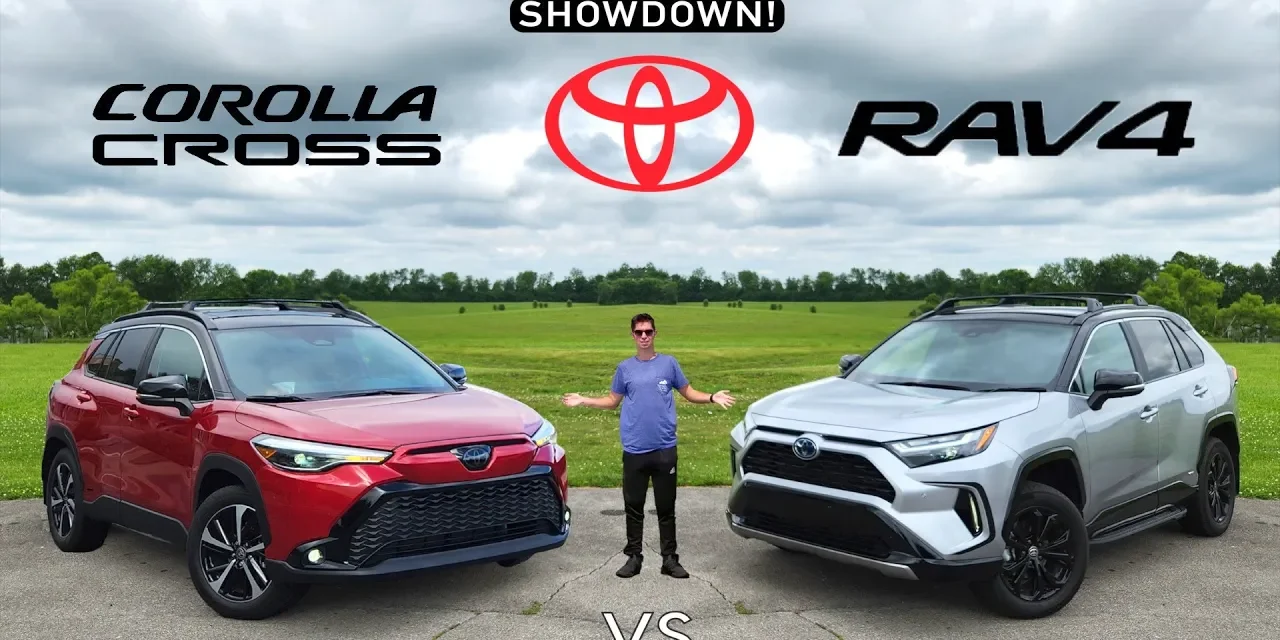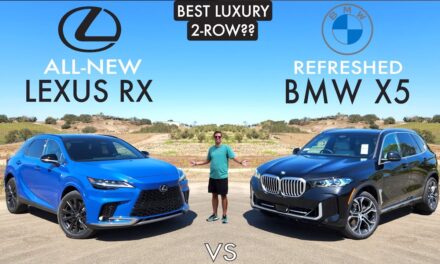American’s love crossovers, and when it comes to CUV’s, Toyota is one of the brands doing the most. Their lineup is full of options galore, and most recently, they turned their legendary Corolla sedan into one as well. But that also means there is some overlap, and the new Corolla Cross certainly has some people wondering if they could save some money and pick it over the best-selling RAV4. So, which of these two siblings represents the best value for your money in the 2023 Toyota RAV4 vs. Corolla Cross battle?
Pricing and Equipment
So, first off, let’s talk pricing as that is the main difference between these two SUVs.
Starting with the updated RAV4, we have the sporty, yet high end XSE trim level. Toyota offers quite a few options and our tester checked almost all of those, making its total price $41,985, after destination.
RAV4 (Hybrid XSE AWD): $36,885 | Options: +$3,765 | Destination: $1,335 | Total: $41,985
The smaller Corolla Cross is positioned below the RAV4 in terms of size and price. In its equivalent XSE trim level, it comes in at an as tested price of $35,565 after 3 grand of options.
Corolla Cross (Hybrid XSE AWD): $31,065 | Options: +$3,165 | Destination: $1,335 | Total: $35,565
If you’re new to our comparisons, we do them in an objective way. We have done our best to weigh the points awarded throughout in major and minor categories.
Exterior Design
Seeing these two side-by-side, you’ll notice that they share some family resemblance, but the Corolla Cross has its own flavor. It features an aggressive, blacked out lower fascia that extends all the way to the ground, while the RAV4 has a tougher and boxier overall look. We won’t be awarding points based on design, but as far as features, we have projector LED lighting on both. There are some differences, though. Only the Corolla Cross has adaptive abilities and LED foglamps, and only the RAV4 has a premium LED accent strip.
Continuing to the sides, the RAV4 is bigger than the Corolla Cross but not by as much as you might think. It’s only about 4 inches longer overall, and both feature two-tone roofs and nice 18-inch alloy wheels as equipped. The only thing worth mentioning is the RAV4 XSE includes premium gloss black wheel arches compared to matte ones on the Corolla Cross.
Length: 180.9-inches (RAV4) | 176.8 inches (Corolla Cross)
Rolling on through the exteriors, we have the rear designs. The RAV4 has more style back here but features wise they are very similar. Both have partially LED taillights and exposed wipers, but only the RAV4 has dual exposed exhaust outlets.
For towing, the bigger RAV4 can tow about 15% more at 1,750 lbs. vs. the Corolla Cross’s 1,500 lb. maximum.
Additional Features
Now moving on to some individual odd and end features, both Toyota’s have the same mirrors with LED turn signals, heating, and blind spot monitoring.
And one of the really nice things about both crossovers is that Toyota includes all four of your major active safety features as standard equipment, and their warranties are the same as expected.
But things are going to get even more interesting on the inside, so let’s get into that.

Interior Design
Approaching both SUVs, they have smart entry systems with branded key fobs. They also have sensors behind the door handle and after opening the doors, you’re going to see spacious, tech filled cabins.
Before we dig into the tech and features, let’s first start with the seats. They have black SofTex leatherette seating for their XSE trim levels, and the only difference is the color of accenting in the middle. Additionally, they have a 10-way power adjustment with lumbar support and are heated for those of you in cold climates. Only the RAV4 has 2-person memory abilities.
Now once we climb inside the cabins, we can check out the major point category of material quality. This is where you start to see some sacrifices on the Corolla’s end for the price. The materials aren’t bad per say, but they have a less solid and premium feel than the RAV4. The RAV4 has quite a bit more soft touch plastic and leatherette to class up the cabin.
Firing the Toyota’s up, you’ll see a new full 12.3-inch digital cluster on the RAV4 this year, compared to a 7-inch helper display on the Corolla.
The RAV4 also has an available HUD but not on the XSE trim, and moving back, they both have heated, leather wrapped steering wheels. Only the RAV4 has rain sensing wipers.
Storage and Technology
Now it’s time to evaluate a major interior section: storage. This is a big difference between these two, since the Corolla Cross is pretty much identical to the sedan, with a tight center console and limited storage beyond that. Meanwhile, the RAV4 shines like the California sun with a gigantic center console, large and deep cupholders plus a passenger storage shelf. It’ll get the point here, and both have wireless phone chargers.
Thankfully, Toyota has left traditional shifters on both models and when in reverse, you’ll see an advanced 360-degree camera on the RAV4 which is not available on the Corolla Cross.
As far as climate both have dual zone automatic setups, and as far as audio, we have different JBL audio systems. Let’s take a listen. While neither audio system will knock your socks off, the RAV4’s does have a richer sound with its two extra speakers and subwoofer.
Corolla Cross: 9-speaker JBL Premium audio
RAV4: 11-speaker 800-watt JBL Premium audio
When we first opened the door, I said these two were tech filled, and that is mainly because of these advanced displays. The RAV4 gets a big upgrade for 2023 to this 10.5-inch display. The Corolla Cross will have to make do with an 8-inch display instead, and both are running Toyota’s newest software with wireless ACP and AA abilities. They also both have integrated navigation systems, as well.
As we wrap up the front of the cabins, the RAV4 has a couple more advantages. Both have auto-dimming mirrors with HomeLink remotes, but only the RAV4’s is also a camera mirror when you flip the switch.
It also has the optional panoramic sunroof, which is something not offered on the Corolla Cross.

Rear Seats and Cargo
So, the RAV4 has more storage and more tech features than the Corolla Cross, but does it have a significant space difference in the rear? To answer that question, we need not go any further than the specs. The RAV4 comes in at a whopping 16% more rear legroom than the Corolla Cross, although the headroom is nearly identical.
Corolla Cross: 32.0 inches for legroom | 39.1-inches headroom
RAV4: 37.8 inches of legroom | 39.5-inches of headroom
Despite that difference in rear space, they have the same feature set with standard vents, USB ports and fold-down center armrests. The RAV4 can get heated rear seats, but once again, it isn’t available on the XSE trim level.
Moving out back, the two crossovers have power tailgates, but only the RAV4 has the hands-free foot activation.
Unsurprisingly, once the tailgate opens, the RAV4 is going to have a significant advantage when it comes to cargo space. Behind the 2nd row seats, the RAV4 comes in a massive 54% larger, and with them folded, it still retains about a 12% advantage.
RAV4: Behind 2nd row: 37.6 cubic feet | Max: 69.8 cu.ft
Corolla Cross: Behind 2nd row: 21.5 cubic feet | Max: 61.8 cu.ft
Alright, we’re done with the interiors now, so it’s time to take this close comparison out to the streets for the 2023 Toyota RAV4 vs. Corolla Cross.

Powertrain
So as you’ve seen throughout this comparison, these two are closer to each other in terms of space and features more than you’d think. But with that substantial price difference, we see a large difference under the hood. While both models are offered in hybrid form, which is what we have today, the RAV4 will be using the larger 2.5L 4-cylinder setup which makes 11% more horsepower at 219 vs. 196 in the Corolla Cross. We tested both these models out for a full week, and the RAV4 has the better acceleration and feels less strained.
0-60 Times (MotorTrend Tested):
- Corolla Cross: 8.0s
- RAV4 Hybrid: 7.3s
RAV4: 2.5L I-4 + Elec: 219 hp
Corolla Cross: 2.0L I-4 + Elec: 196 hp
As far as the transmissions, both the RAV4 and Corolla Cross use efficient eCVT’s and have standard AWD systems.
Driving Impressions and fuel economy
Now let’s talk about an important part for any family SUV; the ride quality. Both are comfortable for their respective segments, but the RAV4 once again takes the lead. It has a more premium suspension tuning and more comfortable seating which makes it the better overall experience.
But that experience isn’t all about ride quality. You might be wondering how quiet they are. Tested at 55 MPH on local smooth highways, both came in at very similar numbers within 1 decibel of each other, meaning they are indistinguishable to the average adult ear.
RAV4: 56.7 dB @ 55 MPH
Corolla Cross: 57.4 dB @ 55 MPH
Lastly, fuel economy is a strong suit for both of these crossovers. They are incredibly efficient and rated at an impressive 40 and 42 MPG combined for RAV4 and Corolla Cross respectively which is less than the 5% difference required to score a point. That being said, we drove both models for hundreds of miles during our week-long tests, and surprisingly the RAV4 came out ahead of the Corolla Cross in our real-world fuel economy tests. While the RAV4 achieved its rating, the Corolla underperformed probably due to the less power hybrid system straining more. In the real world, we have an 8% difference.
RAV4: 41/38/40 MPG | 40.5 MPG (observed real-world)
Corolla Cross: 45/38/42 MPG | 37.3 MPG (observed real-world)
The Corolla Cross also has a much smaller fuel 10-gallon fuel tank which means you will be stopping to fill up more often regardless.
Toyota Siblings Winner!
So there you have it; the objective winner is the RAV4, but let’s discuss who should be “your” winner…
Corolla Cross:
- Best value (quite a bit cheaper than equivalent RAV4)
- Premium lighting (adaptive LED headlights & fog lights)
- Sleeker design
RAV4:
- Most luxury & tech offered (pano roof, larger display)
- More space (especially in rear seats, cargo)
- Better powertrain experience (more powerful and better real-world fuel economy)
Now we want to know your opinions, so make sure to head to the comment section and let us know which one you would pick!
Anyway, thanks for joining us for another Car Confections Comparison, and be sure to watch the video below for a full visual comparison.













Recent Comments